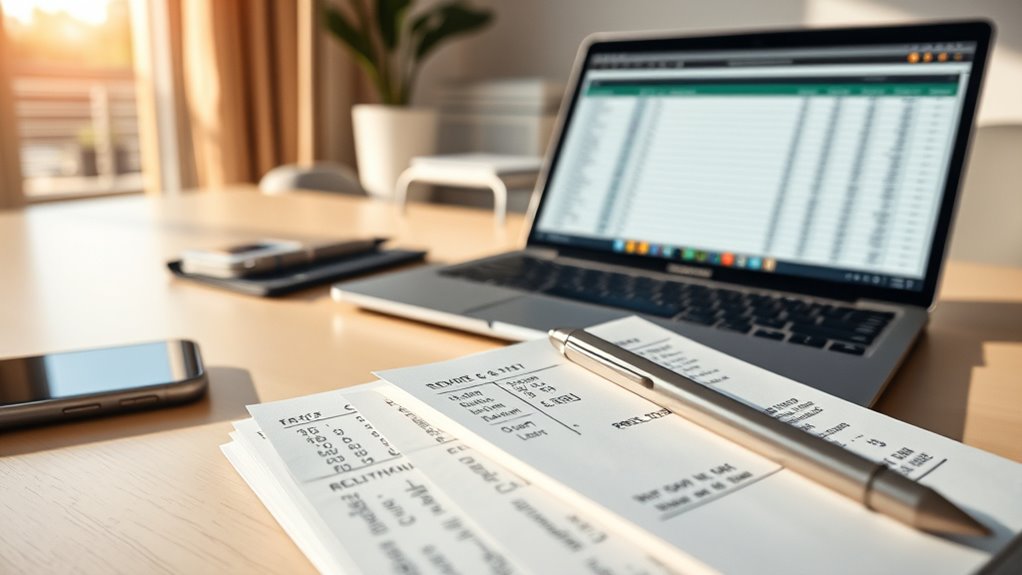To document travel expenses for work or reimbursement, keep all receipts organized by expense type, either in a dedicated folder or using digital apps. Take photos of receipts immediately and record details like date, vendor, and amount. Follow your company’s guidelines for submitting receipts and include explanations for expenses like tips or cash payments. Staying organized and understanding the procedures guarantees smooth reimbursement and compliance—learn more to make this process even easier.
Key Takeaways
- Keep detailed, legible receipts and photographs to verify all travel-related expenses.
- Categorize and label receipts by expense type for easier organization and reporting.
- Follow your company’s specific guidelines for submitting and documenting travel expenses.
- Record expenses without receipts, such as tips, with detailed logs and explanations.
- Store all documentation securely until expenses are fully reimbursed to prevent loss or disputes.

When managing travel expenses, proper documentation is essential to guarantee reimbursement and maintain accurate records. You need to stay organized from the moment you incur a cost, ensuring every expense is backed by appropriate proof. Receipts management plays a crucial role here. As you go about your trip, keep all receipts in a dedicated folder or digital app. This prevents losing vital records and makes the process of expense reporting smoother. When it’s time to submit your expenses, having clear, legible receipts helps verify the costs you’ve incurred, reducing delays or disputes with accounting teams. Additionally, be mindful of the signs of spoiled receipts or documents, such as discoloration or damage, which can make verification difficult. Understanding expense reporting procedures is equally important. Many organizations have specific guidelines for submitting travel expenses, including what types of receipts are acceptable and how to categorize expenses. Familiarize yourself with these procedures beforehand. For example, some companies require original paper receipts, while others accept digital copies. Keep in mind that some expenses, like tips or incidental costs, might need separate documentation or detailed descriptions. By knowing your company’s rules, you can prepare your documentation accordingly, avoiding errors that could delay reimbursement. To streamline receipts management, consider digital solutions. Use your smartphone to scan or photograph receipts immediately after purchase. Many expense management apps allow you to upload receipts directly, timestamping them for easy reference later. This approach minimizes clutter, reduces the risk of losing physical copies, and simplifies the process of matching receipts with corresponding expenses. When organizing your receipts, clearly label or categorize them based on expense type—lodging, meals, transportation—so that during expense reporting procedures, everything is easy to locate and verify. Properly managing receipt organization is key to efficient expense processing. Being diligent about documentation also means noting the details on each receipt. Record the date, vendor, and amount spent right away, especially if the receipt isn’t clear. For expenses that don’t come with receipts, like tips paid in cash, keep a detailed log explaining the expense and the reason for reimbursement. This additional documentation can be vital if questions arise during review. Finally, ensure that your receipts and expense records are stored securely until your expense report is approved and reimbursed. Double-check that your documentation aligns with your company’s policies before submitting. Proper receipts management combined with a good understanding of expense reporting procedures not only speeds up reimbursement but also protects you from potential audit issues. Staying organized and precise makes the entire process more efficient, letting you focus on your trip instead of administrative hassles.
Frequently Asked Questions
Can I Use Digital Receipts Instead of Paper Ones?
Yes, you can use digital receipts instead of paper receipts. Many companies accept digital receipts because they’re convenient and environmentally friendly. Just make certain the digital receipts are clear, legible, and include all necessary details like date, amount, and vendor information. Keep digital copies organized and backed up, as some reimbursement processes may require you to submit them electronically. Always check your company’s specific policies to confirm digital receipts are acceptable.
How Long Should I Keep Travel Expense Records?
Think of your travel expense records as treasures that need guarding. You should keep them for at least the duration specified by record retention policies, usually 3 to 7 years, depending on your location or employer rules. Using digital record management makes this easier, ensuring your documents stay safe and accessible. Regularly review and back up your files to stay compliant and prepared for audits or reimbursements.
Are Tips Included in Reimbursable Travel Expenses?
Tips are generally included in reimbursable travel expenses if they relate directly to your work, like meal deductions or mileage tracking. When documenting expenses, make certain tips are itemized separately if required, and keep receipts. Some companies or IRS rules may have specific guidelines, so always check your organization’s policies. Properly tracking your mileage and noting meal tips helps maximize your reimbursements and ensures accurate record-keeping.
What if Receipts Are Lost or Damaged?
If you lose receipts or they’re damaged, don’t worry. You can use digital documentation, like bank statements or credit card records, to prove your expenses. It’s also helpful to write down details of the expense, such as date, amount, and purpose, as backup. Check your company’s policy first, but generally, providing alternative proof like digital copies or detailed notes can help guarantee your expenses are reimbursed.
Can I Claim Expenses for Personal Travel Days?
You can claim expenses for personal travel days, but only if they’re directly related to work. Keep in mind, you’ll need to separate personal travel from business travel to avoid mixing apples and oranges. Using travel insurance can help cover unexpected costs, and mileage deductions are available if you drive for work purposes. Just make sure to keep detailed records, so you’re not caught between a rock and a hard place.
Conclusion
Remember, documenting your travel expenses is like packing your bag—you want everything in its right place. Without proper records, your trip might feel like a journey without a destination, leaving you empty-handed during reimbursement. By keeping detailed receipts and notes, you turn a chaotic adventure into a smooth ride. So, stay organized; it’s the map that guides your expenses home, ensuring you get reimbursed without detours or delays.









